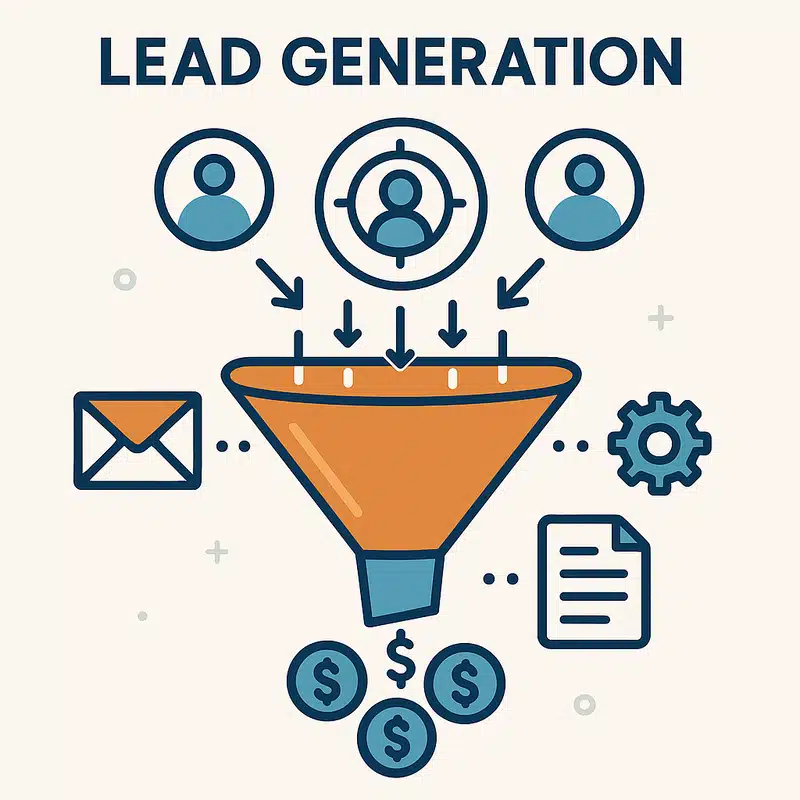- 1. Lead Generation & Nurturing
- 2. Customer Support & Call Handling
- 3. Invoice Processing & Payment Reminders
- 4. Employee Onboarding
- 5. Social Media Management
- 6. Marketing Campaigns & Email Sequences
- 7. Document Management
- 8. Appointment Scheduling
- 9. IT Support & Security Monitoring
- 10. Sales Pipeline & CRM Updates
- Conclusion
10 Business Workflows You Can Automate Today

- 1. Lead Generation & Nurturing
- 2. Customer Support & Call Handling
- 3. Invoice Processing & Payment Reminders
- 4. Employee Onboarding
- 5. Social Media Management
- 6. Marketing Campaigns & Email Sequences
- 7. Document Management
- 8. Appointment Scheduling
- 9. IT Support & Security Monitoring
- 10. Sales Pipeline & CRM Updates
- Conclusion
The present competitive market benefits from automation because it enables organizations to simplify operations while lowering mistakes and directing energy toward business expansion.
The implementation of AI, together with RPA and workflow automation tools, boosts organizational efficiency, which produces rapid, accurate performance results.
1. Lead Generation & Nurturing

Challenges: Manual data entry, slow response times, inconsistent follow-ups.
The success of business operations heavily depends on lead generation and nurturing, although these practices create difficulties because of manual data processing, delayed responses, and unstable follow-up procedures. Time spent on these tasks prevents organizations from dedicating resources to client interactions and deal closures.
Automation Solutions:
- AI-powered chatbots: Website visitors can communicate with these chatbots in real time to collect necessary information while answering the questions most commonly asked by users. Implementing these chatbots frees your team members to concentrate on crucial projects instead of basic tasks.
- Automated email sequences: The sequences guide leads through personalized time-based messages tailored to their behavioural activities. Through automated lead management, leads get appropriate messages at suitable times, which boosts their conversion potential.
- CRM integration: Your CRM system can integrate with automation tools to monitor and grade prospective leads. The system ensures your team works on the most important prospects to optimize lead management operations.
Key Benefits:
Businesses improve conversion rates through automatic lead generation and nurturing because it lets them provide quicker responses to potential clients.
Through personalized communication at the right time, businesses achieve higher conversion rates when dealing with prospects. The system delivers improved customer experience through its capability to deliver consistent and relevant interactions.
2. Customer Support & Call Handling

Challenges: Long wait times, inconsistent responses, and high agent workload.
Client satisfaction success depends on customer support, although this system faces obstacles related to extended wait durations, scattered answers, and excessive workload on support staff.
Automation Solutions:
- AI-powered voice agents: A white label AI voice agent can handle inbound inquiries, provide automated responses, take orders, and process customer requests. Automating routine tasks reduces the burden on human agents, allowing them to focus on more complex issues. The quick response capability delivers better customer satisfaction.
- AI-powered IVR systems: System routing mechanisms evaluate customer intentions to connect them with appropriate departments or representatives, thus shortening waiting periods and enhancing service quality.
- CRM integration: Agents gain instant access to customer historical data through automation systems, which allows them to deliver personalized service more efficiently.
Key Benefits:
Through automation, providers can respond to customer inquiries more swiftly, which leads to shorter waiting times and contented clients. The system reduces operational expenses through its ability to operate without a big support team while maintaining service quality.
The brand delivers personalized support quickly to customers, which creates a better experience for them.
3. Invoice Processing & Payment Reminders

Challenges: Late payments, manual data entry, reconciliation errors.
Late payments and errors in invoice processing are common challenges for businesses, especially when manual data entry and paper-based systems are involved. These issues can negatively impact cash flow and create unnecessary complications.
Automation Solutions:
- AI-powered OCR: This technology scans and processes invoices automatically, extracting key information and eliminating manual data entry. It greatly reduces the risk of human errors in the invoicing process.
- Automated payment reminders: An automated email or SMS notification system should alert clients about unpaid bills to keep cash flow positive and decrease late payments.
- Accounting software integration: The connection of reconciliation to your accounting systems automates the process to ensure both records remain precise and current.
Key Benefits:
The automation process accelerates invoice processing from start to finish, which speeds up payment reception and decreases error rates. Timely payments improve financial operations while also enhancing cash flow and making the business operation more efficient.
4. Employee Onboarding
Challenges: Lengthy paperwork, inconsistent training, manual task assignment.
The process of welcoming new employees typically creates obstacles through document processing schedule coordination and traditional manual job distribution. When HR teams do not apply automation, they become burdened with manual onboarding operations that lead to delayed processes, causing negative effects on the new hire experience.
Automation Solutions:
- Pre-scheduled emails and training materials: Welcoming new employees typically creates obstacles through document processing schedule coordination and traditional manual job distribution. Due to the manual management of onboarding procedures by HR teams, the process becomes slow, resulting in adverse outcomes for new recruits.
- Automated document collection and verification: HR departments can use automation to collect and verify mandatory documents, cutting down manual documentation workloads.
- HR workflow automation: Through automation, the system dispatches work assignments and determines entry permissions, which helps employees integrate into the organization without waiting periods.
Key Benefits:
Automation of onboarding procedures allows businesses to expedite the time needed for new hires to start their work. The system enables complete compliance with requirements, which reduces potential risks. The employee experience becomes better through automation because it provides a streamlined and standardized process.
5. Social Media Management

Challenges: Time-consuming content posting and inconsistent engagement.
Social media management demands consistent creation of content and posting aside from active follower interaction. Social media management requires manual work that proves time-consuming and inefficient.
Automation Solutions:
- Scheduling posts: The business tools Buffer and Hootsuite let companies arrange and organize social media content in advance for scheduled posting. The social media content scheduling platform allows businesses to create regular posting schedules, which decreases time spent on social media activities.
- AI-powered content recommendations: AI analyzes what your audience likes to recommend content that will gain their interest and boost post relevance.
- Automated performance tracking and reporting: Automated tracking systems allow you to monitor your postings and campaigns for performance metrics that guide your upcoming social media strategy development.
Key Benefits:
Maintaining a steady online presence benefits from automation because it enables continuous posting schedule execution.
Through automated functions and targeted content creation, social media platforms achieve better engagement levels while tracking performance data for better future marketing.
Businesses achieve better performance outcomes by refining their strategies by using automated tools that generate data-driven insights.
6. Marketing Campaigns & Email Sequences

Challenges: Manual email sends, lack of personalization, difficulty tracking performance.
The combination of manual email sending, inadequate personalization, and poor measurement of campaign results creates marketing campaign challenges that make them overwhelming for marketers.
The obstacles create conditions that result in both lost chances and reduced participant interaction rates.
Automation Solutions:
- Automated email workflows: This workflow technology provides personalized email messages based on user behaviour to demonstrate proper communication at the right time.
- Dynamic content personalization: Using AI, content can be dynamically tailored to individual preferences, making your email campaigns more relevant and engaging.
- Marketing automation tools: Tools like HubSpot or ActiveCampaign help streamline your marketing campaigns, from lead nurturing to performance tracking, saving time and improving campaign effectiveness.
Key Benefits:
Automated marketing initiatives generate better customer interaction because they can create personalized and pertinent content delivery. Time efficiency through marketing automation allows marketers to shift their efforts from manual tasks to strategic planning.
Automation tools enhance business investment returns through optimized campaign initiatives and improved conversion numbers.
7. Document Management
Challenges: Error-prone manual data entry and time-consuming document retrieval.
Urgent document management tasks through human-operated systems trigger multiple errors and delays that produce operational slowdowns along with user dissatisfaction in document retrieval processes.
Automation Solutions:
- AI-powered data extraction: The automatic extraction of important document data through AI eliminates manual entry tasks while ensuring higher accuracy.
- Document categorization: Using OCR and NLP, documents can be categorized automatically, making retrieving and organizing easier.
- Cloud-based storage with automated tagging: Cloud storage systems can automatically tag and categorize documents, ensuring they are easily accessible and well-organized.
Key Benefits:
The automated document management system decreases human errors and speeds up document retrieval operations. The efficiency of documents increases through automation because repetitive tasks become easier to manage, and files can be stored in a single accessible system.
8. Appointment Scheduling
Challenges: Back-and-forth emails, double bookings, no-show appointments.
The scheduling process through email exchanges leads to multiple issues, including long patient-provider communication times, double bookings, and scheduling errors.
Automation Solutions:
- AI-powered scheduling assistants: Tools like Calendly or Microsoft Bookings allow customers to schedule appointments based on available time slots, reducing the need for back-and-forth emails.
- Automated reminders: Automated reminders are sent via email or SMS, reducing the likelihood of no-shows and ensuring that appointments are kept.
- CRM integration: Integration with CRM systems helps track and manage appointments, providing businesses and clients with a clear overview of upcoming meetings.
Key Benefits:
The automated appointment scheduling system reduces the chances of scheduling conflicts and appointment no-shows. The system enhances operational performance by removing manual coordination processes that preserve customer-business orders.
9. IT Support & Security Monitoring

Challenges: Slow response to IT issues, security vulnerabilities, and manual ticketing.
The requirement for IT support and security directly increases with the digital transformation of contemporary business operations. Businesses encounter problems because they receive delayed IT problem resolution while dealing with security vulnerabilities and manual support systems that damage operational efficiency and security measures.
Automation Solutions:
- AI-powered monitoring: Automated systems can monitor your IT infrastructure for cybersecurity threats, ensuring that potential issues are addressed before they escalate.
- Automated software updates: Automation ensures that all systems are up-to-date with the latest security patches, reducing vulnerabilities and keeping your systems secure.
- IT helpdesk chatbots: Chatbots can assist with common IT support issues, guiding users through troubleshooting steps or creating tickets for more complex problems.
Key Benefits:
Businesses benefit from automation systems that deliver fast and efficient IT problem handling that leads to shorter system downtime. Security gets automatic protection through the combination of vulnerability detection and resolution capabilities.
Automated information technology processes help IT teams manage their essential responsibilities by decreasing their workload.
10. Sales Pipeline & CRM Updates
Challenges: Tracking deal progress, manual CRM updates, inconsistent follow-ups.
Sales teams need to spend significant time updating their CRM system manually. This process creates system inconsistencies. The current tracking system fails because sales representatives have to update CRM systems manually while also ensuring they contact leads at specific times.
Automation Solutions:
- Automated lead scoring: AI-powered tools can automatically score and qualify leads based on their behaviour and interactions, ensuring that high-value prospects are prioritized.
- AI-driven deal forecasting: Tools can predict the likelihood of a deal closing, helping sales teams focus on the most promising opportunities.
- CRM workflow automation: Automation moves leads through the sales process, from initial contact to closing the deal, ensuring that no leads fall through the cracks.
Key Benefits:
The automation of sales pipeline management enables sales teams to achieve higher productivity because it frees them from repetitive work, which lets them commit their efforts to important business activities.
The improved accuracy of sales forecasts helps businesses to base their decisions on data records. Automating follow-up procedures leads sales teams to increase their conversion rate of leads into customers.
Conclusion
Workflow automation is an important business technology enabling organizations to achieve greater efficiency, reduced costs, and better accuracy.
Automating essential business functions, including lead acquisition and customer help to invoice management and IT protection, allows companies to optimize their workflows, thus delivering superior performance and service experiences to staff and customers.
The outcome allows organizations to move quickly through changes and exploit new growth possibilities quickly and effectively.
Organizations that accept automation technology gain operational excellence and market advantage, allowing them to excel in their rapidly evolving technology-based industry.

Abhijit Sarkar
Hi, I’m Abhijit Sarkar. I am deeply passionate about creating engaging content and exploring. My journey includes gaining valuable experience in content writing and creating useful resources for my readers.

Leave a Reply